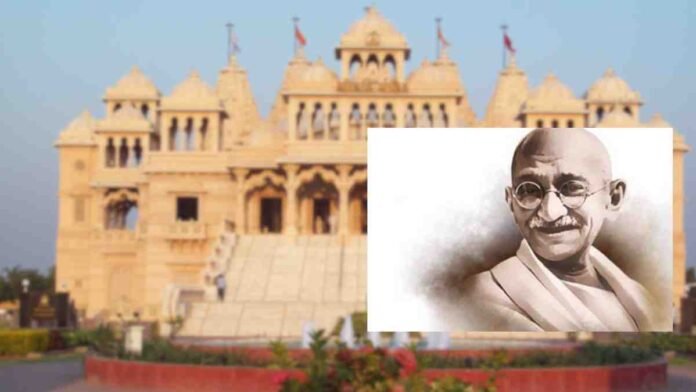Gandhi Jayanti, celebrated on October 2nd each year, is a historic festival commemorating Mahatma Gandhi, the Father of the Nation. This day commemorates his vital contributions to India’s freedom, as well as his long-standing ideal of nonviolence and truth. Exploring Gandhi’s legacy via travel provides a unique opportunity to engage with the locations that influenced his life and teachings. By visiting these major places, visitors may obtain a better understanding of his principles and reflect on their relevance in today’s society.
1. Porbandar: The Birthplace of the Mahatma
Porbandar, Gujarat, is historically significant as the birthplace of Mahatma Gandhi, who was born here in 1869. This coastal city is noted not only for its historical significance but also for the picturesque splendour of the Arabian Sea. One of the main attractions of Porbandar is Kirti Mandir, Gandhi’s family house that has been converted into a museum. This website provides information on his early life and the ideals that moulded him. Porbandar’s rich history and scenic surroundings make it a must-see destination for anybody looking to connect with Gandhi’s legacy.

2. Sabarmati Ashram: A Hub of Freedom Struggle
The Sabarmati Ashram in Ahmedabad is historically noteworthy because it housed Mahatma Gandhi at a critical phase in India’s struggle for independence. The ashram, founded in 1917, served as a centre for Gandhi to organize different actions, notably the Non-Cooperation Movement and the Salt March.
The ashram is well-known for its quiet and tranquil atmosphere, which embodies Gandhi’s ideal of simplicity and self-reliance. Visitors may explore the magnificent gardens and peaceful surroundings that influenced many of his ideas and beliefs.

Furthermore, the ashram has museums and exhibitions related to Gandhi’s life and beliefs. These exhibits give insight into his journey by displaying images, letters, and objects that demonstrate his dedication to nonviolence and civil disobedience. The Sabarmati Ashram not only honours Gandhi’s legacy, but it also acts as a source of inspiration for individuals who want to learn more about the ideas of peace and justice that he advocated.
3. Dandi: The Salt March Route
Dandi: The Salt March Route is historically significant as the location where Mahatma Gandhi launched the Salt March in 1930. This march was a significant act of civil disobedience against British salt regulations, which levied high charges on salt, an essential requirement for the Indian populace. Gandhi’s decision to march to Dandi to produce salt from saltwater represented the struggle for India’s freedom and demonstrated the power of nonviolent protest.

Readers are urged to travel along this historic road to experience Gandhi’s ideas of nonviolence and civil disobedience. Walking this trail may be a poignant reminder of the fight for justice and freedom, provoking contemplation on the importance of these ideas in today’s society.
4. New Delhi: Raj Ghat and Memorials
Raj Ghat, a notable memorial to Mahatma Gandhi, is located in New Delhi. This beautiful location symbolizes the spot where Gandhi was cremated in 1948. Every year on Gandhi Jayanti, a big celebration is held here, with people from all walks of life coming to pay their respects. The memorial has an everlasting flame and a plain black marble pedestal, which represent his humility and commitment to peace.

In addition to Raj Ghat, numerous additional places in the area help to preserve Gandhi’s legacy. The National Gandhi Museum, for example, houses a significant collection of Gandhi’s images, papers, and personal possessions. It gives visitors a better knowledge of his life, philosophy, and the fight for India’s freedom. These memorials and museums serve an important role in preserving Gandhi’s teachings, acting as reminders of his dedication to nonviolence and truth for future generations.
5. Gandhi Jayanti Celebrations: Local Events and Activities
Gandhi Jayanti is celebrated throughout India with a variety of local festivities and activities honouring Mahatma Gandhi’s legacy. Many towns undertake cleanliness programs to honour Gandhi’s goal of a clean, sustainable India. These initiatives inspire people to clean up public places, parks, and communities, instilling a feeling of community and duty.
In addition to cleaning programs, there are frequent debates and seminars on Gandhi’s teachings, with speakers delving into issues such as nonviolence, peace, and social justice. These events give an opportunity for individuals to think on Gandhi’s teachings and how they might be applied to contemporary issues.
Cultural events such as plays, music concerts, and art exhibitions are also popular at this season. These activities honour Gandhi’s life and accomplishments via narrative and creative expression, making his teachings more accessible to a larger audience.
Travelers can join in these festivals in a variety of ways. They can participate in local cleaning initiatives to benefit their communities while experiencing a feeling of cooperation and service. Attending lectures and cultural activities not only broadens their grasp of Gandhi’s philosophy but also allows them to interact with locals and other tourists who are passionate about his principles.
Travellers can also visit venues like Raj Ghat in Delhi, where ceremonial commemorations, like as prayers and tributes are held. By actively engaging in these activities, visitors may commemorate Gandhi’s principles and obtain a better understanding of his effect on Indian culture and the globe at large.
Conclusion:
Readers are encouraged to use Gandhi’s values of nonviolence, honesty, and simplicity in their own lives while they travel. Visiting historical locations related to him might help them appreciate his legacy and emphasize its relevance in today’s society.



